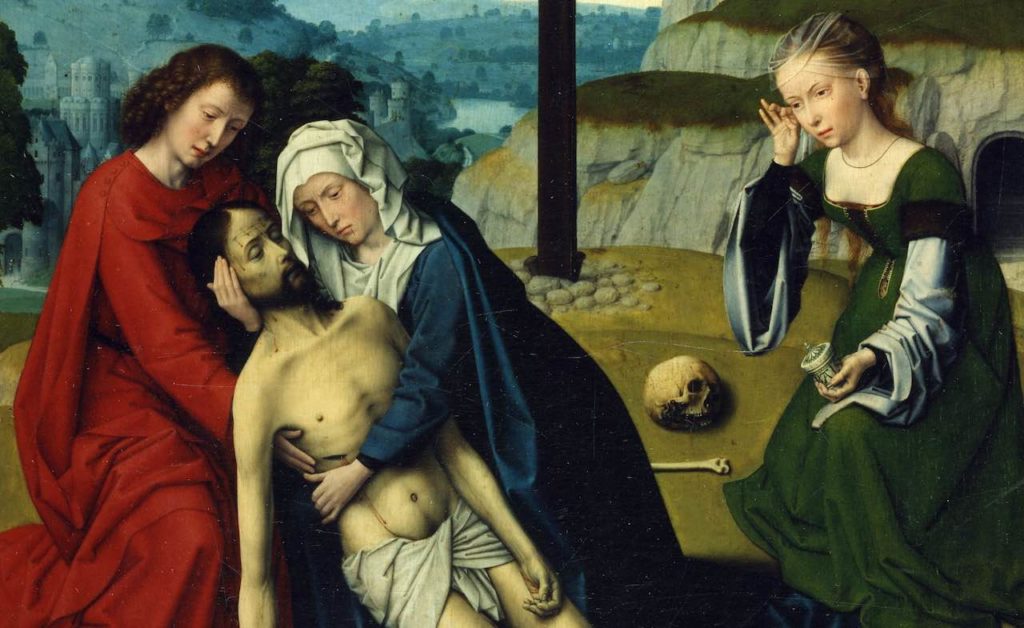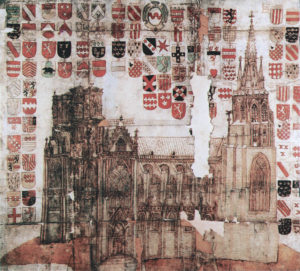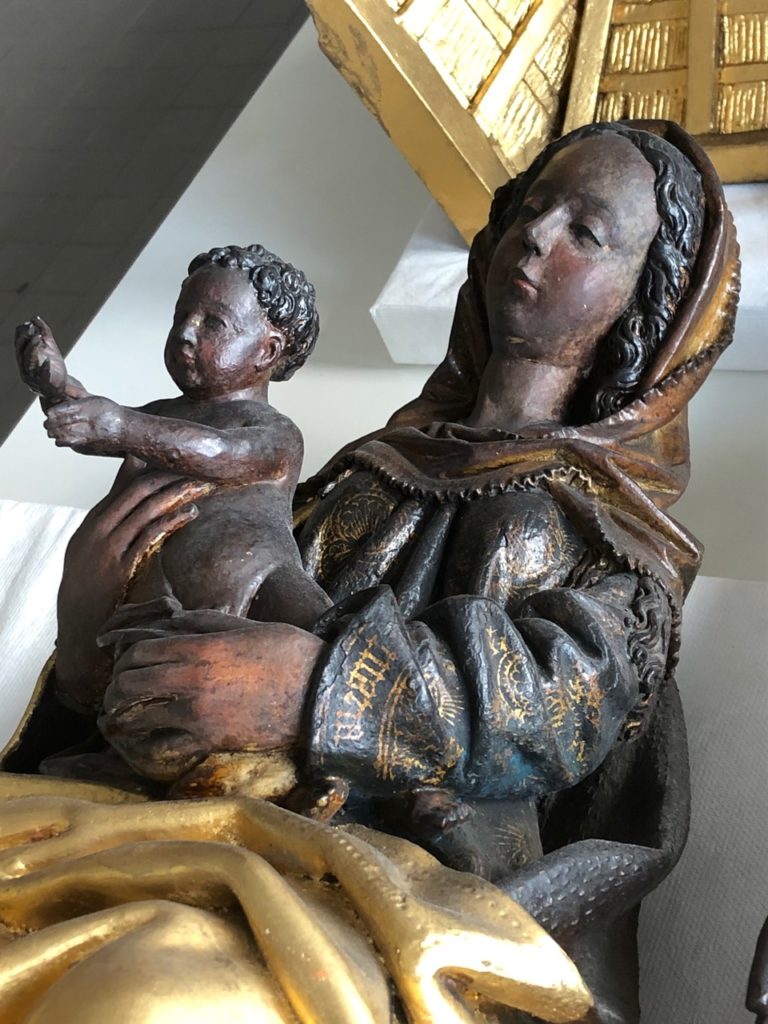Call for applications \ Doctoral Fellowship
Applications for the 2024 Doctoral Fellowship are now open. Applications must be received by 13 February 2024.
read moreApplications for the 2024 Doctoral Fellowship are now open. Applications must be received by 13 February 2024.
read moreFrom 2023 onwards, the Fondation Périer-D’Ieteren will allocate €50,000 each year to one or more projects for the acquisition, conservation, restoration or valorisation of a work (15th-18th centuries) intended for or belonging to a Belgian public or religious institution. The project must demonstrate the artistic or historical value of the work and must clearly highlight the promotion policy that will be developed once the work has been acquired and/or restored. Restoration work must be carried out by a qualified restorer working in Belgium.
The application must be submitted by 31 December 2023. The application conditions are set out in this document (in French).
The library of the Fondation Périer-D’Ieteren will be exceptionally closed on Friday 4 August. During the month of August, the library will be open at its usual times. More information on the Library & Archives page of our website.
Call for Papers: Cultural Crossroads: Artistic Encounters between the Low Countries and Spain, 15th-17th Centuries. I.- Flemish Paintings in Spain (Brussels, 24 November 2023)
The export of art produced in the Southern Netherlands to the Iberian Peninsula is a well-known research topic. The importance of the economic links, based mainly on the trade in wool from Castile for the looms of Flanders and Brabant, contributed to the creation of a commercial network for the dissemination of works from the North throughout the Iberian Peninsula. In addition, the close diplomatic and dynastic ties between the houses of Burgundy and Habsburg on the one hand and the Catholic sovereigns of Spain on the other favoured the emergence of major patrons. These included Isabel the Catholic, but also Diego de Guevara. Numerous paintings, tapestries, sculptures, and stained-glass windows thus found their way into Spanish collections, whether private or public, civil or religious, where they have often remained to this day.
Since 2020, the Instituto Moll (Madrid) and the Fondation Périer-D’Ieteren (Brussels) have been carrying out a research programme aimed at identifying and studying the art of the Southern Netherlands from the 15th to 17th centuries that is still preserved in Spanish collections today.
By focusing initially on paintings (15th-17th centuries), this project responds directly to the needs of researchers expressed as early as 1953 with the publication of the first repertoire of the Centre for Flemish Primitives devoted to the Spanish collections, under the direction of Jacques Lavalleye[1]. The very objective of the repertory was “to make known unpublished or less studied paintings (…) fragmentarily explored by scholars”. Unfortunately, only two volumes will be published, which will leave in the shadows several important paintings. More recently, the work of Elisa Bermejo, Matias Díaz Padrón and Didier Martens, the large survey of the Burgos and Palencia regions by Pilar Silva Maroto, the Las Edades del Hombre exhibitions held since the end of the 1980s, Constanza Negrín Delgado’s and Ana Diéguez Rodríguez’s doctoral dissertations, as well as the publications of the scientific catalogues of Spanish museums’ collections have reproduced and studied a large number of little-known or previously unpublished Flemish paintings[2]. All these publications have made it possible to envisage a more extensive census to broaden the range of research topics and to make professionals and a wider public aware of the artistic and heritage issues of these works.

To continue the dynamic initiated by these predecessors, the Instituto Moll and the Fondation Périer-D’Ieteren are organising a series of study days dedicated to this subject. The aim of this first study day, focusing on paintings, is to offer short contributions on a little-known Flemish painting or group of paintings (15th-17th century) preserved in Spain. Other conferences devoted to the different art forms will be organised as part of this project.
Conference panels:
1. Expand the catalogue of painters and their workshops: new research
2. Workshop practices, collaborations, and serial production
3. Success stories: iconographies and compositions
4. Patrons, collectors, and the art market
5. Material and technical studies, conservation and restoration issues
The authors of the selected proposals will be invited to speak at the study day to be held on 24 November 2023 at the Fondation Périer-D’Ieteren (Brussels). Papers will be presented in English, French or Spanish and will be 15-20 minutes in length. The proceedings of the study day will be published in the Cahiers d’étude series of Annales d’Histoire de l’Art et d’Archéologie in 2024 and the works discussed during the day will be included in the database currently being created by the Instituto Moll and the Fondation Périer-D’Ieteren.
If you wish to participate in this study day, please send a provisional title, a short abstract of your paper (300 words) and a CV by 30 July 2023 to: Ana Diéguez Rodriguez (congreso@institutomoll.es) and Sacha Zdanov (sacha.zdanov@perier-dieteren.org). The organizers will respond by 31 August 2023.
Organizers:
– Dr Ana Diéguez Rodriguez, Instituto Moll / Universidad de Burgos
– Dr Sacha Zdanov, Fondation Périer-D’Ieteren / Université Libre de Bruxelles
[1] J. Lavalleye (dir.), Collections d’Espagne, (= Les Primitif flamands, II. Répertoire des peintures flamandes des quinzième et seizième siècles 1), 2 volumes, Antwerp, 1953-1958.
[2] E. Bermejo, La pintura de los primitivos flamencos en España, 2 volumes, Madrid, 1980-1982; M. Díaz Padrón (dir.), Splendeurs d’Espagne et les villes belges, 1500-1700, Brussels, 1985; M.P. Silva Maroto, Pintura hispanoflamenca castellana: Burgos y Palencia. Obras en tablas y sarga, 3 volumes, Valladolid, 1990; Didier Martens, Peinture flamande et goût ibérique aux XVème et XVIème siècles, Brussels, 2010; Constanza Negrín Delgado, El arte de los Países Bajos de los siglos XVI y XVII en las Islas Canarias, doctoral thesis, Universidad Complutense de Madrid, 1993; Ana Diéguez Rodríguez, La Pintura flamenca del siglo XVI en el norte de España: Galicia, Asturias, Cantabria, País Vasco y Navarra, doctoral thesis, Universidade de Santiago de Compostela, 2012.
From 7 to 10 March 2023, the Foundation welcomed two experts in stained glass, Isabelle Lecocq (IRPA) and Yvette van den Bemden (UNamur), who discussed diverse aspects related to the production and conservation of stained glass (historical evolution, commissions, techniques etc.). New avenues of research were presented, in particular with regard to the connections between stained glass and the paintings of Hugo van der Goes and Pieter Coecke van Aelst, the study of preparatory drawings (small-scale drawings, cartoons, etc.), and the iconographic study of small medallion panels and rondels. A particularly difficult question addressed during the seminar concerned the authenticity of the attribution of stained glass, which is complicated, since no stained glass window has been transmitted without alteration.

The Périer-D’Ieteren Foundation recently acquired the digital documentation of Louise Longneaux’ PhD dissertation on Tapestry cartoons in 16th-century Brussels (unfinished due to private reasons). All research material and photographs collected are now available to scholars who envision new research on this topic.
In this way, the Foundation, which also holds the extensive archive of Sophie Schneebalg-Perelman (available upon request), hopes to stimulate new interest in the field of tapestry.
Applications for the Preliminary Study Grants (conservation-restoration) are now open. Applications must be received by 30 September 2022.
read moreApplications for the Publication Grant are now open. Applications must be received by 30 September 2022.
read moreThe Adoration of the Magi altarpiece from the San Nazaro Maggiore Basilica in Milan has arrived at the Royal Institute for Cultural Heritage on 15 March 2022 for study and restoration. Coordinated by the Périer-D’Ieteren Foundation since 2017, this project finally got off the ground thanks to the support of the King Baudouin Foundation (René & Karin Jonckheere Fund and Jean-Jacques Comhaire Fund) and the Soprintendenza of Milan.
The altarpiece is currently undergoing a series of tests prior to restoration. The conservation treatment is set to start after the first meeting of the Italian-Belgian scientific committee in late April. While the altarpiece is being restored at the Royal Institute, an in-depth art historical study of this Brussels work, attributed to the Borman dynasty of sculptors, will be carried out. A detailed monograph on the art historical context, execution techniques and restoration will be published at the close of the project.

The lectures of the Périer-D’Ieteren Foundation, organised as part of the painting and heritage conservation seminar (HAAR-B5270) of the ULB’s art history and archaeology master’s degree, will be held from 20 to 22 April 2022 on the Foundation’s premises (Rue de Livourne 41, 1050 Brussels). The opening lecture of 19 April 2022 will take place in the Dupréel hall of the ULB (Solbosch campus, building S, floor 1, access Avenue Jeanne 44, 1050 Brussels).
To register for the opening lecture, please send an email to sacha.zdanov@perier-dieteren.org no later than 11 April 2022.
More information on the seminar: link.
